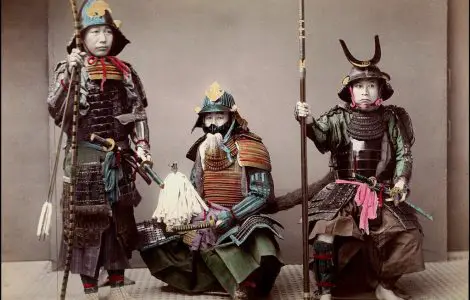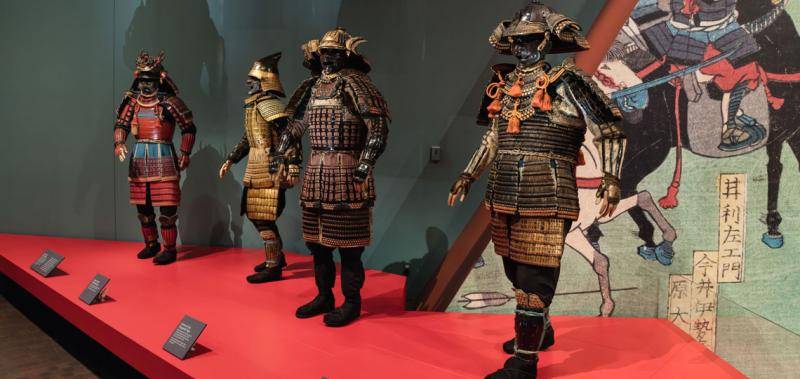Explain Three Different Aspects of Samurai Training
Moreover lectures are also the favored method of delivery for situations wherein the training program needs to cater to a very large audience. Then distribute the cards to.

Knight Vs Samurai What Are The Differences Between Them
Eiko Ikegami examines the nature and historical development of the samurai ethos specifically concepts of honour in the belief that the ideas which evolved among samurai in that context in pre-modern Japan do much to explain the paradox that a society almost universally regarded as conformist has undergone changes in the past 100 years that have been radical even.

. It was not needed to create or establish them. The subtler faculties of prudence intelligence and dialectics were less important. Section 2-The Rise of the Samurai.
This unique philosophy valued honour reckless bravery and selflessness as well as duty to the warriors master with the purpose of giving up ones life and embracing death. Nathan Algren Tom cruise is an American civil war veteran who carries moral scars of his victory against the native. Poetry rock gardens monochrome ink paintings and the tea ceremony were common aspects of samurai culture.
The samurai enthusiastically embraced Confucian ideals due to the advocacy of what they believed was the natural hierarchy of man. Responsibilities of samurai include but are not limited to keeping the daimyo and his family safe protecting the daimyos land castle and property maintaining weapons and armor and always adhering to BushidoThe task of your students is to assume the role of. Explain that the unique geography resources and history of Japan meant that samurai armor looks different from other types of armor students may have seen before.
The samurai began as horse archers which influenced their equipment even as they shifted towards their role as swordsmen. Chapter 22 The Rise of the Warrior Class in Japan HW 524. Emerging from provincial warrior bands the samurai of the Kamakura.
For example pointing to your chest doesnt mean me or I - the Japanese point to their noses. And only then do they make the decision. Japanese culture was evident in samurai training in the study of writing and literature tea ceremony and Buddhism.
Prepared from a very young age samurai and knights were trained in many aspects such as combat strategy serving a lord and honor above all else. However its also worth mentioning that lectures do have certain weaknesses. Raising your eyebrows to say hello means come on to the Japanese and if you do the thumbs down sign youre actually saying go to hell.
This every experienced US. As a child he had but to be instructed as indeed he was from his earliest years in. 646 which included land redistribution and heavy new taxes meant to support an elaborate Chinese-style empire.
The rigorous training of samurai. There was no place for fear in the way of the warrior and this conduct of self discipline and respectful ethical behaviour was to become the role. Samurai practiced calligraphy and wrote poetry.
Manager will say with a shudder is not for us however well it might work for the Japanese. Section 7-Training for the Tea Ceremony. The samurai of thirty years ago had behind him a thousand years of training in the law of honor obedience duty and self-sacrifice.
The reforms forced many small farmers to sell their land and work as tenant farmers. Finally it is a mans obligation to teach his children moral standards through the model of his own behavior. Intellectual superiority was esteemed but a samurai was essentially a man of action.
For one thing its relatively inflexible since it relies exclusively on a one-way delivery of information. The term samurai was originally used to denote the aristocratic warriors bushi but it came to apply to all the members of the warrior class that rose to power in the 12th century and dominated the Japanese government until the Meiji Restoration in 1868. When they entered their rank of either knight or samurai.
Introduction to The Last Samurai Edward Zwick the director of legend of the fall co-produced this 2003 war and drama film based on a true story depicting honor and courage battling against corruption and greed. Emerging late in the first millennium AD the samurai were a warrior aristocracy. Gestures and body language work differently in Japan.
This activity includes 3 excerpts from the Bushido code and two images of armour from the Shogun period. This approach can lead only to. Poetry and spiritual discipline.
Updated on July 24 2019. They also studied subjects such as calligraphy literature and flower arranging. The first objective of samurai education was to build up Character.
Section 3-The Samurais Armor and Weapons. Show students the Materials Cards and go through each one together to introduce the different products that could be used to make armor. They studied the tea ceremony which fostered a spirit of harmony reverence and calm and practiced Buddhism which taught discipline and focus.
Japanese culture was evident in samurai training in the study of writing and literature tea ceremony and Buddhism. They studied the tea ceremony which fostered a spirit of harmony reverence and calm and practiced Buddhism which taught discipline and focus. Section 6-Training in Writing and literature.
Samurai were a class of highly skilled warriors that arose in Japan after the Taika reforms of AD. The Samurai Creed The role religion played in the Samurais life Tradition of the Samurai Feelings on death for the Samurai Honor of the Samurai Bushido 7 Principles of the Samurai. To the samurai loyalty to superiors was never questioned.
The front two page is an easy to read informative text about the Samurai the Bushido code and the Gusoku. The young warriors studied Kenda the art of fencing with bamboo sticks the moral code of the samurai and Zen Buddhism. Samurai practiced calligraphy and wrote poetry.
Section 4-Military Training and Fighting. Samurai member of the Japanese warrior caste. This three page worksheet is designed to helps students build a strong understanding of Japan in context as they study the Shogun period.
Began in childhood. Explain 4 from the 7 items given below. Role of tradition and beliefs Tradition and honor played a major role in the life of a Samurai warrior.
School was a unique combination of physical training. The basis of samurai conduct is bushido the way of the warrior. Their Shinto gods established the order when they created the world but Confucius articulated how the Japanese should view their shoguns daimyos and samurai.
As landowners and leaders of society even the lowliest of samurai were wealthier and more privileged than most Japanese people.

Yoair Blog The World S Anthropology Blog Publication


No comments for "Explain Three Different Aspects of Samurai Training"
Post a Comment